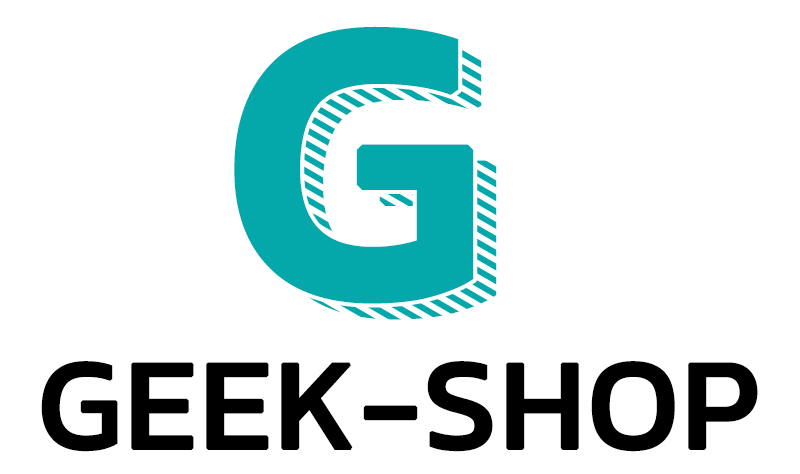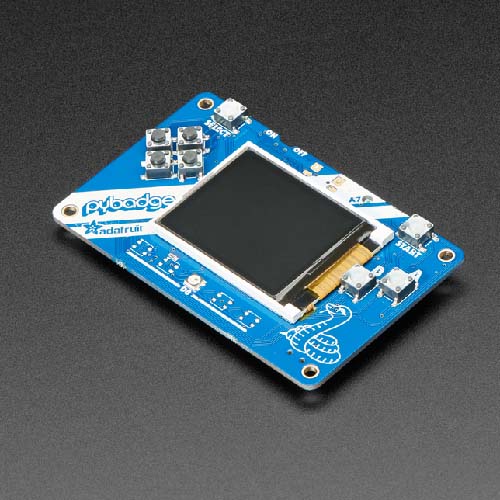Adafruit PyBadge
CHF 75.90
What's the size of a credit card and can run CircuitPython, MakeCode Arcade or Arduino? That's right, its the Adafruit PyBadge! We wanted to see how much we could cram into a 3 3⁄8 × 2 1⁄8 inch rounded rectangle, to make an all-in-one dev board with a lot of possibilities, and this is what we came up with.
The PyBadge is a compact board, like we said, it's credit card sized. It's powered by our favorite chip, the ATSAMD51, with 512KB of flash and 192KB of RAM. We add 2 MB of QSPI flash for file storage, handy for images, fonts, sounds, or game assets.
On the front you get a 1.8" 160x128 color TFT display with dimmable backlight - we have fast DMA support for drawing so updates are incredibly fast. There's also 8 silicone-top buttons, they are clicky but have a soft button top so they're nice and grippy. The buttons are arranged to mimic a gaming handheld, with a d-pad, 2 menu-select buttons and 2 fire-action buttons. There's also 5 NeoPixel LEDs to dazzle or track activity.
On the back we have a full Feather-compatible header socket set, so you can plug in any FeatherWing to expand the capabilities of the PyBadge. There's also 3 STEMMA connectors - two 3-pin with ADC/PWM capability and one 4-pin that connects to I2C - you can use this for Grove sensors as well.
For built in sensors, there's a light sensor that points out the front, and a 3-axis accelerometer that can detect taps and free-fall. To make bleeps and bloops, there's a built in buzzer-speaker. For projects where you need more volume, you can plug in one of our 8 ohm speakers.
You can power the PyBadge from any of our LiPoly batteries. An on-off switch will save battery power when not in use. Or power from the Micro USB port - it will also charge up the battery if one is attached.
Now, how to program it? Well you've got a lot of options!
MakeCode Arcade is the easiest to start for making games, you can drag-and-drop blocks and load games over the disk-drive bootloader
CircuitPython lets you draw graphics, play wave files and print out text in any fonts - all in Python! There's tons of sensor support as well.
Arduino is low level, powerful, but a little more challenging. You can use Adafruit Arcada to interface with the hardware and it will abstract some of the nitty-gritty details like reading buttons for you.
Here's a list of everything you get
ATSAMD51J19 @ 120MHz with 3.3V logic/power - 512KB of FLASH + 192KB of RAM
2 MB of SPI Flash for storing images, sounds, animations, whatever!
1.8" 160x128 Color TFT Display connected to its own SPI port
8 x Game/Control Buttons with nice silicone button tops (these feel great)
5 x NeoPixels for badge dazzle, or game score-keeping
Triple-axis accelerometer (motion sensor)
Light sensor, reverse-mount so that it points out the front
Built in buzzer mini-speaker
Mono Class-D speaker driver for 4-8 ohm speakers, up to 2 Watts
LiPoly battery port with built in recharging capability
USB port for battery charging, programming and debugging
Two female header strips with Feather-compatible pinout so you can plug any FeatherWings in
JST ports for NeoPixels, sensor input, and I2C (you can fit I2C Grove connectors in here)
Reset button
On-Off switch
Zusätzliche Information
| Gewicht | 0.200 kg |
|---|

